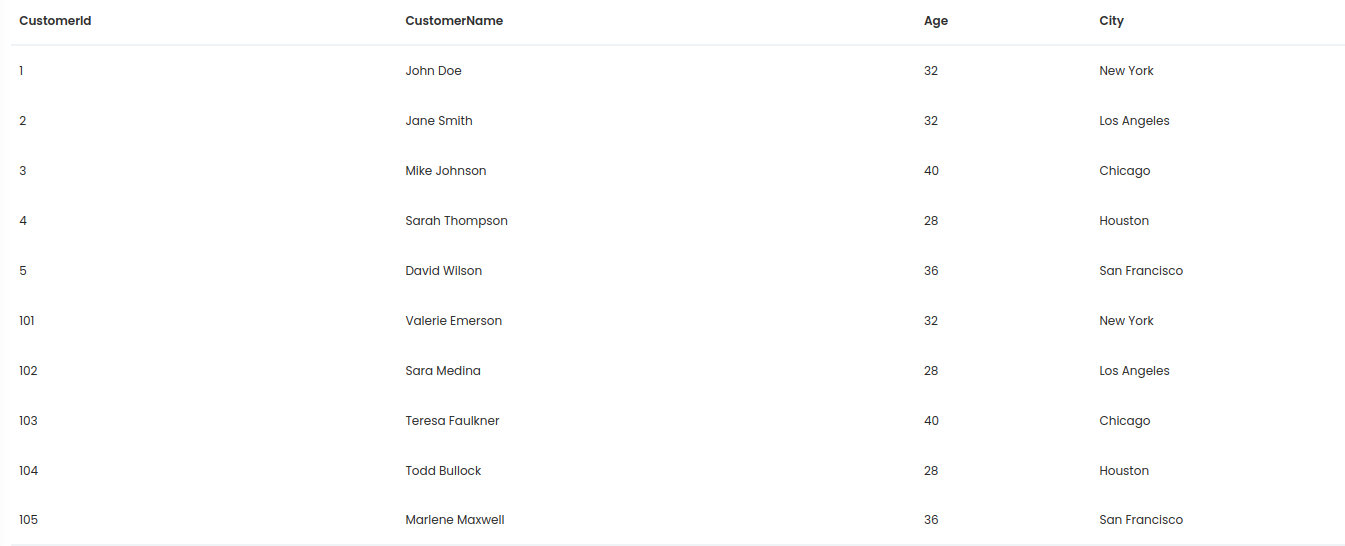Examples of SQL Queries used in ShardOne
With a basic understanding of SQL and its associated clauses established, the next step involves delving into practical examples that illustrate the process of querying datasources using ShardOne.
For that define a few tables and map aliases to them:
Datasource: CustomersMySQL (A MySQL DB)
- Item: Users
- Item Alias: Customers
- Field Alias:
- ID -> CustomerId
- Name -> CustomerName
+----+----------------+-----+---------------+
| ID | Name | Age | City |
+----+----------------+-----+---------------+
| 1 | John Doe | 32 | New York |
| 2 | Jane Smith | 32 | Los Angeles |
| 3 | Mike Johnson | 40 | Chicago |
| 4 | Sarah Thompson | 28 | Houston |
| 5 | David Wilson | 36 | San Francisco |
+----+----------------+-----+---------------+
Datasource: CustomersMongo (A MongoDB)
- Items: Persons
- Item Alias: Customers
- Field Alias:
- User_ID -> CustomerId
- Person_Name -> CustomerName
+---------+-----------------+-----+---------------+
| User_ID | Person_Name | Age | City |
+---------+-----------------+-----+---------------+
| 101 | Valerie Emerson | 32 | New York |
| 102 | Sara Medina | 28 | Los Angeles |
| 103 | Teresa Faulkner | 40 | Chicago |
| 104 | Todd Bullock | 28 | Houston |
| 105 | Marlene Maxwell | 36 | San Francisco |
+---------+-----------------+-----+---------------+
Datasource: OrdersOracle (An Oracle DB)
Table: Orders
+----+---------+-------+
| ID | OrderID | Price |
+----+---------+-------+
| 1 | 1001 | 50 |
| 2 | 1002 | 75 |
| 3 | 1003 | 60 |
| 4 | 1004 | 45 |
| 6 | 1005 | 55 |
+----+---------+-------+
List all available Customers
SELECT * FROM Customers;
As it can be seen, with a single query, ShardOne fetches data from 2 different datasoucres. This was possible because the item and the fields in the 2 tables were mapped to a single Item Alias and respective Field Alias.
List the customers from New York.
SELECT City, UPPER(CustomerName)
FROM Customers
WHERE City = 'New York'
List the first 5 customers sort by age in ascending order
SELECT * FROM Customers
ORDER BY Age
LIMIT 5
OFFSET 2
List the customers from New York and Los Angeles
SELECT *
FROM Customers
WHERE City = 'New York' OR City = 'Los Angeles'
List the cities where the customers are from.
SELECT DISTINCT City
FROM CustomersCount the number of customers from each city.
SELECT City, COUNT(City) as `Count`
FROM Customers
GROUP BY City
List the cities having more than 1 customer
SELECT City, COUNT(City) as `Count`
FROM Customers
GROUP BY City
HAVING `Count` > 1
List the customers and their orders
SELECT *
FROM Customers as c
JOIN `OrdersOracle.Orders` as o
ON c.CustomerId = o.ID
The Orders table are referenced as
OrdersOracle.Ordersi.e.<Datasource Name>.<Table Name>as there was no Alias mapped to it.List the details of the orders with prices more than 60
SELECT *
FROM Customers as c
JOIN `MySQL.documentation_demo.Orders` as o
ON c.CustomerId = o.ID AND o.Price >= 60